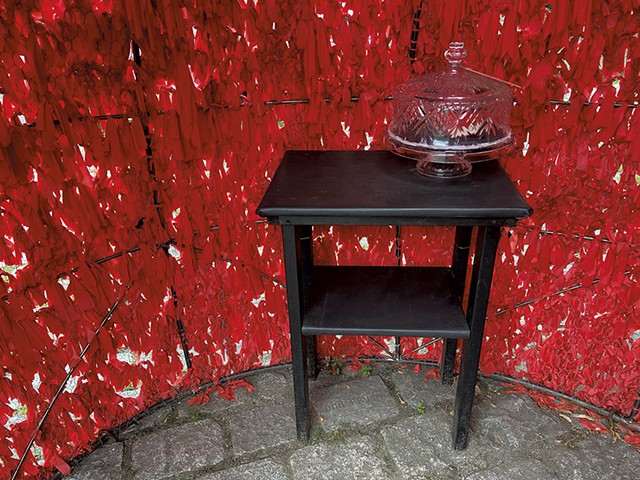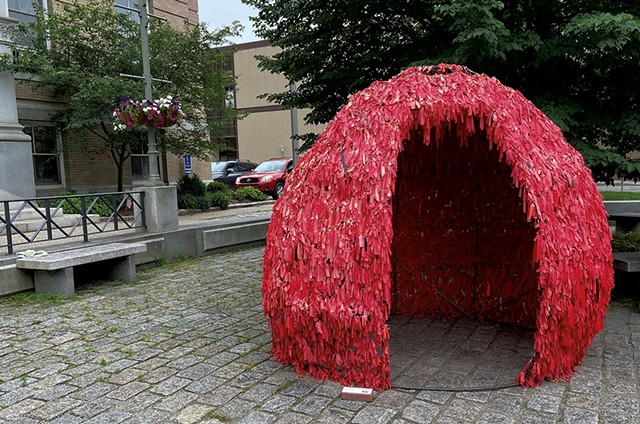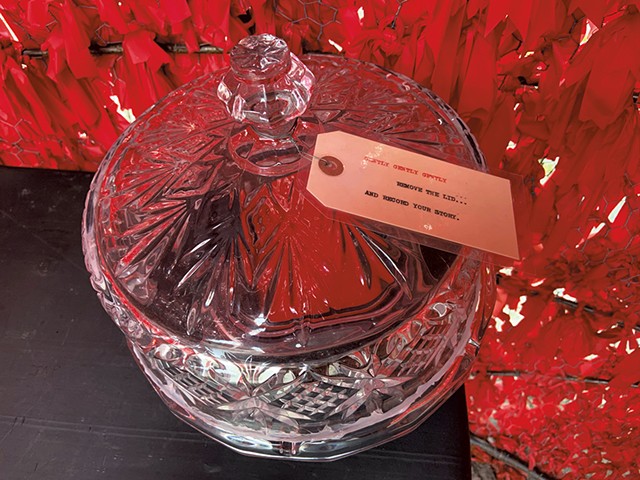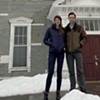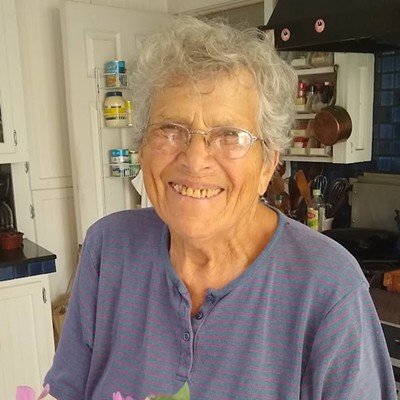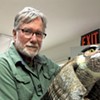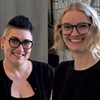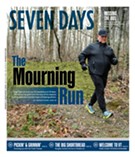Switch to the mobile version of this page.
Vermont's Independent Voice
- News
- Arts+Culture
- Home+Design
- Food
- Cannabis
- Music
- On Screen
- Events
- Jobs
- Obituaries
- Classifieds
- Personals
Browse News
Departments
Browse Arts + Culture
View All
local resources
Browse Food + Drink
View All
Browse Cannabis
View All
-
Business

Cannabis Company Could Lose License for Using…
-
Culture

'Cannasations' Podcaster Kris Brown Aims to 'Humanize'…
-
True 802

A Burlington Cannabis Shop Plans to Host…
-
Business

Judge Tosses Burlington Cannabiz Owner's Lawsuit
-
Health + Fitness

Vermont's Cannabis Nurse Hotline Answers Health Questions…
Browse Music
View All
Browse On Screen
Browse Events
Browse Classifieds
Browse Personals
-

If you're looking for "I Spys," dating or LTRs, this is your scene.
View Profiles
Special Reports
Pubs+More
Susan Calza’s Installation in Montpelier Invites Telling Stories About Trying Times
Published July 20, 2022 at 10:00 a.m.
The golden dome topping the Vermont Statehouse is Montpelier's iconic architectural feature. But a new structure in front of city hall is in the running for eye-catching color — at least until the end of July.
For the past couple of months, Main Street passersby have been perplexed — and compelled — by a yurt-like edifice, its exterior a shaggy coat of red tape flaps, in front of the old municipal building of brick and granite. The curious structure is "Red Oculus: Our Year of the Preposterous," the work of Montpelier-based artist Susan Calza. Installed in May, following a June through November run at the Bennington Museum in 2021, the piece is Calza's artistic response to the COVID-19 pandemic. Its form was inspired by the nasty, spiky fuzz ball image of the virus.
"I conceived [the piece] when vaccines were just starting to come out," Calza says. "No matter where we went, when we turned around, we saw that red blob."
The bold color clash with earth-toned Montpelier City Hall makes "Red Oculus" a visually alluring attraction. Its wide entryway — there's no door or door flap — affords a view inside a space comfortable for one person, maybe two. The titular oculus is the round opening in the enclosure's ceiling.
Approaching "Red Oculus," one can see a small table inside, the sole piece of furniture. On the table sits a glass cake dome that covers a plastic bin containing notebooks and pens. A tag attached to the cake dome reads, "Gently Gently Gently Remove the Lid...and Record Your Story." ("Red Oculus" initially contained vintage cassette tape recorders. Calza was able to gather audio testimony from visitors for a while, but the machines were eventually stolen.)
Its loud appearance notwithstanding, up close "Red Oculus" is a retreat for sharing reflections.
"I wanted something that was light but that people could go inside, and if they had a heavy story they could leave it," Calza says. "The piece is large but also intimate."
Within the context of Calza's art career, which began in the early 1980s, "Red Oculus" demonstrates her interest in art that touches on social and political issues and evokes universal themes. "I'm absolutely convinced that all art is born out of loss," she says. Her recent work has engaged with such challenging subjects as immigration, the slave trade, mass shootings and homelessness. Calza opened her eponymous gallery in Montpelier in 2018 in response, as she writes in her most recent artist statement, to "untenable injustices sensationalized by our media platforms, paradoxically leaving us feeling 'informed,' yet overwhelmed and powerless."
"Red Oculus," while using the pandemic as a nominal frame, offers visitors a way to acknowledge our common suffering — and maybe even some joy — in all their variety. "Everything you're feeling, everyone else is feeling to one degree or another," Calza says.
What people inside "Red Oculus" have been feeling testifies both to the challenges of life in these "preposterous" times and to public art's capacity to engage an audience at emotional depth. The entries range from the merely informative — "I was born in California and lived in a house surrounded by flowers, and now I live in Vermont. I am 7 years old." — to the forlorn — "What the fuck is happening to this world?" From the inspirational — "My story is too vast to leave here. I have had many different names and all the genders. Most importantly, I have learned to love myselves." — to the distraught — "My dad hits me." "I am Black and I feel hated."
Some read like entries in a B&B guest log: "Hello from Michigan! Just passing through on a road trip. Montpelier is amazing!" Others reveal people in pain, in love, grateful or geared up for whatever comes next: "I graduate from college next May and after years of hardship, it's all coming together. Don't give up! Keep going! I [heart] you."
Some visitors are moved to poetic expression, as in these lines from local "concerned citizen" Morgan Brown (who agreed to share his name, though most "Red Oculus" responses are anonymous): "One is left to wonder / whether they are within / a tender, living heart, / either that or an exhibit of art, / beating away vigorously, / art imitating life, / life imitating art." And some are just happy to connect: "I am here with everyone else who has written in this book. Thank you for being here too."
Calza has been pleased by the public's interaction with "Red Oculus" and, in fact, "amazed," she says, by the story of youth in distress that has come through in the notebooks, which she collects daily (along with stray beer bottles). She notes that the work situates differently in Montpelier than it did among more of a "museum-going crowd" in its Bennington run.
To architect Ward Joyce, chair of the Montpelier Public Art Commission, which helped fund "Red Oculus" here, the piece has been a success. Its "dynamic physical presence" serves the commission's longer-term goal of identifying and utilizing public spaces to "make the city more artistically vibrant, a better place to visit, to attract people, to add value to the downtown," he says. "Red Oculus" exemplifies public art that he calls "tactical urbanism," in which public engagement, not merely aesthetic appreciation, is key. This art should "stimulate our community's thinking about public art," he says.
Joyce adds that Calza's project got the commission's green light with the expectation that it would develop as a "two-layer" piece, ideally one that could make use of the city's recently purchased outdoor projector — the kind that throws images onto buildings. After "Red Oculus" comes down, Calza will develop the video portion of the project during a residency at the Massachusetts Museum of Contemporary Art in North Adams.
She'll work with footage that she'll gather from participants who reply to invitation cards left in "Red Oculus." She'll also use footage from her winter 2021 collaboration with Vermont artist Kelly Holt, titled "Barely Touching," which showed from late February through early April 2021 at Axel's Frame Shop & Gallery in Waterbury.
In collaboration again with Holt, who met Calza as a grad student at Johnson State College when Calza was on the faculty, a new piece is slated for October with the working title "Listening...a Visual Tapestry of Change." Holt maintains her own photography-based art practice and supports Calza's through grant writing, social media management and gallery direction. She says the work will become a "video salon" that will weave stories in a "tapestry" that uses images and voices but allows participants to be anonymous.
This intention aligns with Calza's belief that art is a "conversation," not entertainment, including when the conversation turns critically toward her work — as it surely might. After all, as one youthful visitor to "Red Oculus" demonstrated, everyone is a critic: "I'm 11 years old and I love this work of art. From my point of view, this looks like a Dragon egg, + I [heart] Dragons!!!"
Calza appreciates the feedback: "What else do we have except our voices?"
The original print version of this article was headlined "Art for Our Sake"
Related Locations
-
Vermont Statehouse
- 115 State St., Montpelier Barre/Montpelier VT 05633
- 44.26262;-72.58054
-
 802-828-0749
802-828-0749
-
Be the first to review this location!
Got something to say?
Send a letter to the editor
and we'll publish your feedback in print!
Tags: Visual Art, Interactive Art, Red Oculus, Our Year of the Preposterous, Susan Calza, Vermont Statehouse
More By This Author
About The Author

Erik Esckilsen
Bio:
Erik Esckilsen is a freelance writer and Champlain College professor who lives in Burlington.
Erik Esckilsen is a freelance writer and Champlain College professor who lives in Burlington.
Speaking of...
-

Totality Towns: What to Do and See in the Path of the Eclipse
Apr 2, 2024 -

Montpelier: What to See, Do and Eat During the Eclipse
Feb 10, 2024 -

'Cocked and Gagged,' at Susan Calza Gallery, Addresses a Horrific American Phenomenon
Jun 14, 2023 -

Tillie Walden to Become Next Cartoonist Laureate of Vermont
Mar 3, 2023 -

Susan Calza Revisits Her Past in 'Our Demons Are Translucent'
Feb 15, 2023 - More »
Comments
Comments are closed.
From 2014-2020, Seven Days allowed readers to comment on all stories posted on our website. While we've appreciated the suggestions and insights, right now Seven Days is prioritizing our core mission — producing high-quality, responsible local journalism — over moderating online debates between readers.
To criticize, correct or praise our reporting, please send us a letter to the editor or send us a tip. We’ll check it out and report the results.
Online comments may return when we have better tech tools for managing them. Thanks for reading.
- 1. Lydia Kern Receives Fourth Annual Diane Gabriel Visual Artist Award Arts News
- 2. The Magnificent 7: Must See, Must Do, May 15-21 Magnificent 7
- 3. How Do I Get Through My First Mother's Day Without Mom? Ask the Rev.
- 4. Q&A: At the Lanpher Memorial Library in Hyde Park, a "Wind Phone" Connects Callers With Lost Loved Ones Stuck in Vermont
- 5. The Magnificent 7: Must See, Must Do, May 8-14 Magnificent 7
- 6. 'Heavy Kinship' at the Tarrant Gallery Contemplates Bodies and Connectedness Art Review
- 7. Theater Review: 'tick, tick… BOOM!,' Vermont Stage Theater
- 1. How a Vergennes Boatbuilder Is Saving an Endangered Tradition — and Got a Credit in the New 'Shōgun' Culture
- 2. Waitsfield’s Shaina Taub Arrives on Broadway, Starring in Her Own Musical, ‘Suffs’ Theater
- 3. This Manchester Center Family Is a National Show Horse Powerhouse Animals
- 4. Pet Project: Introducing the Winners of the 2024 Best of the Beasts Pet Photo Contest Animals
- 5. Video: Visiting the Kellogg-Hubbard Library’s PoemCity in Montpelier During the Month of April Stuck in Vermont
- 6. Bianca Stone Named New Vermont Poet Laureate Poetry
- 7. Monsignor John McDermott Named Bishop of Burlington Books




























